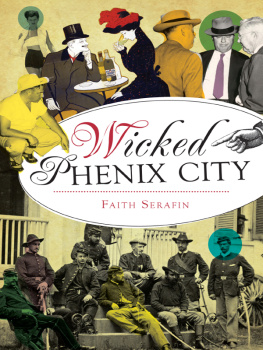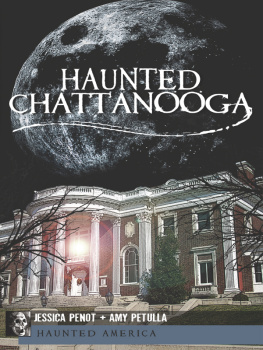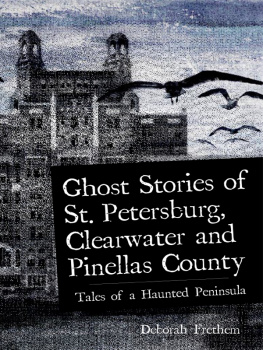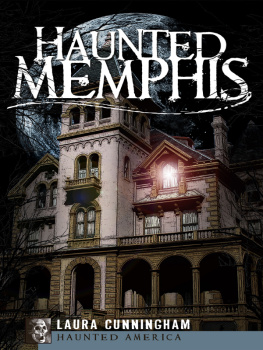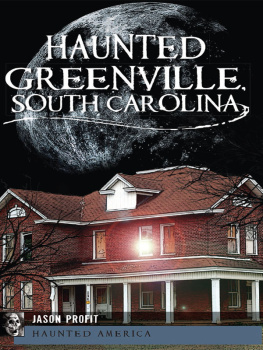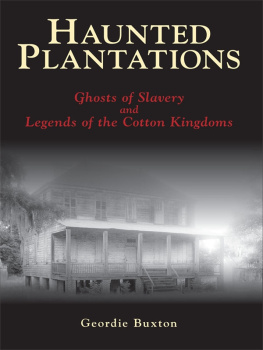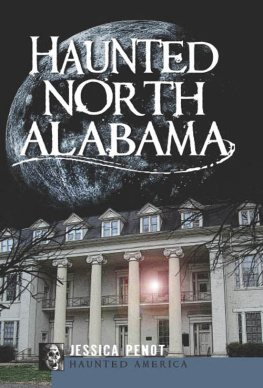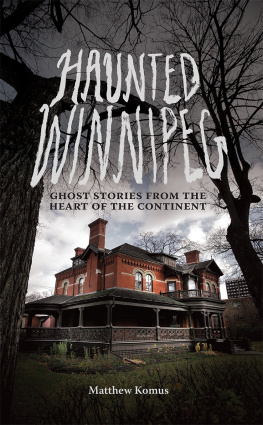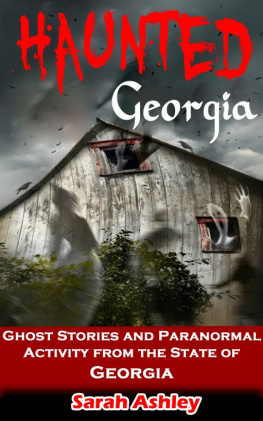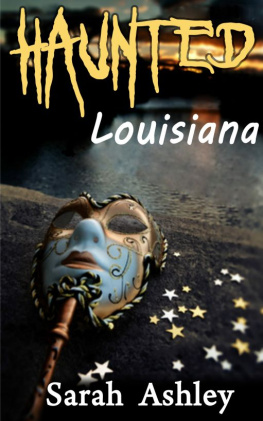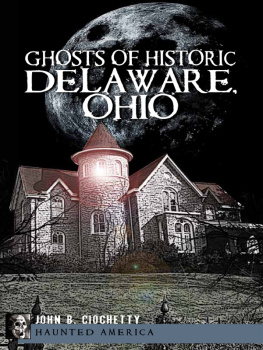Published by Haunted America
A Division of The History Press
Charleston, SC 29403
www.historypress.net
Copyright 2012 by Faith Serafin
All rights reserved
All images courtesy of the author except where noted.
First published 2012
e-book edition 2012
ISBN 978.1.61423.672.6
print ISBN 978.1.60949.552.7
Library of Congress CIP data applied for.
Notice: The information in this book is true and complete to the best of our knowledge. It is offered without guarantee on the part of the author or The History Press. The author and The History Press disclaim all liability in connection with the use of this book.
All rights reserved. No part of this book may be reproduced or transmitted in any form whatsoever without prior written permission from the publisher except in the case of brief quotations embodied in critical articles and reviews.
And my soul from out that shadow that lies floating on the floor Shall be liftedNevermore!
Edgar Allan Poe
CONTENTS
ACKNOWLEDGEMENTS
I would like to recognize all the people who helped contribute to this book in some way. First and foremost, I would like to thank my family for standing by me and supporting me through another haunted adventure, my friends and team members from the Alabama Paranormal Research Team, who relentlessly and passionately, seek out the legends and ghosts of our communities. I would like to acknowledge Bruce Smith and Susan Ingram from the National Civil War Naval Museum. Bruce and Susan supported my research in the paranormal and its relevance to historical objects and locations. I must give great credit to my dear friends Michelle Smith for her help in critiquing my material, and to Tonya Campos for joining me in endless graveyard scavenger hunts. Id also like to recognize Dustin Cooper for rekindling my imagination regarding local unsolved mysteries.
I would like to personally thank everyone who obliged me with interviews in and around the community: Lisa Wyrick and Joyce Cathey, P.J. Adams and award-winning Alcatraz historical interpreter Monica Cobis; the staff at the Rankin House; the Ma Rainey House Museum; and Linwood Cemetery. Also, thanks to everyone who made anonymous contributions, including retired Columbus police officers, military and city officials and to those families and people in the Columbus and surrounding communities who shared with me their eyewitness reports and personal accounts from so many of these stories.
Lastly, I must thank all the paranormal enthusiasts, ghost hunters, legend chasers and curious folks who visit my website daily and those of you who attend events and tours hosted by the Alabama Paranormal Research Team. Your support is what keeps me going and drives me to write down the legends of our past for future generations and for all of you who share a passion for the unusual history America has to offer, thank you for lending me your time in an effort to continue my work for future publications of haunted history.
INTRODUCTION
Columbus, Georgia, also known as the Fountain City, holds onto its secrets like the endless flow of the great Chattahoochee River. Its landscape has changed with time and industry, but the spirits of this city speak out from beyond the grave. This area was once home to the Muscogee Creek Indians. They built a great and thriving empire in this region and, throughout their history, spread a verbal legacy of unusual tales, supernatural beings and legendary beasts.
Columbus was named for the Spanish explorer, Christopher Columbus, and because the Chattahoochee River was navigational by sea, it gave way to direct trade routes between Georgia and many parts of Europe. These included England, France and Spain. These European travelers and settlers added diversity to the native society and changed the course of history by adding their own influence on religious and spiritual aspects of the native culture.
Originally a frontier town, Columbus would undergo a dramatic change in less than a few hundred years. Travelers from all over the world would make their way here and bring with them stories and legends of their own. Columbus tells a story in itself, from Indian legends and folklore to famous frontier ghosts and spirits of Civil War heroes. Phantoms of legendary theater houses and some well-known civil rights activists, politicians and even vaudeville performers called Columbus home, and in death, still linger in their former homes, businesses and final resting places.
The preserved architecture of the city is a ghostly and beautiful reminder of the history here. Many original buildings, such as the Springer Opera House, exist today and are haunted by stories decades old. Magnificent displays of early American ingenuity are proudly displayed up and down Broadway in the buildings, theaters, historical monuments and even New Age art. Everywhere you look there is some sort of history waiting to reach out and grab you.
The hustle and bustle of Columbus, Georgia, echoes throughout history, leaving its mark on those who have lived, worked and died here. Their ghosts call out from beyond the years of historical literature, reaching over oceans of time to resurrect old tales of what once was.
THE GHOSTS OF THE SPRINGER OPERA HOUSE
Columbus, Georgia, has a long and diverse history mixed well into its foundation. These once dusty and dirty streets, riddled with horse-drawn carriages have now given way to automobiles and street lights. The trolley cars of the middle century have long vanished under the sidewalks, but the shadowy presence of an eighteenth-century opera house at 103 Tenth Street still remains.
The Springer Opera House is one of the most spectacular theaters in the South. Its graceful architecture is a beautiful setting of Corinthian columns, heavy aprons, stained glass and a captivating proscenium framed stage. Staircases lead to elaborate balconies overlooking the crowds. Entering the theater arouses an intoxicating mixture of the senses. The sights, smells and even the feel of the old building have a regal appeal that even the simplest folks can truly appreciate.
Francis Joseph Springer was a European immigrant and moved to Columbus before the Civil War. He made his living as a successful grocer and was an avid lover of theater and music. Joseph had a dream to construct a beautiful Victorian theater in Columbus. His contribution and dedication gave birth to the Springer Opera House, which opened on February 21, 1871.
Many wonderful and historical figures have graced the Springer over the last 140 years. Some of the earliest recognized figures include, Edwin Booth, the brother of John Wilkes Booth (who assassinated President Abraham Lincoln). Edwin Booth was a renowned actor of the nineteenth century, performing in Shakespearian plays like Hamlet, and he was regarded as one of the greatest actors of his time. James ONeil, the actor who reluctantly played the leading role in the stage rendition of The Count of Monte Cristo, and Charles Sherwood Stratton, known for his performance as General Tom Thumb, performed here under P.T. Barnum and what is today known as the Barnum and Bailey Circus.
Oscar Wilde, the famed Irish writer and poet, spent a spell in Columbus. His novel The Picture of Dorian Gray portrays Wildes aestheticism. The novel tells the story of Dorian Gray and his portrait, which ages while Dorian stays young. The story was hailed as a literary masterpiece (along with many of Wildes other literary works). Wilde himself was a close and dear friend of Lillie Langtry, known as the Jersey Lily, who performed at the Springer as well. She was a beautiful, British-born woman who was notorious for the many lovers she kept throughout her lifetime. This regal mistress kept the company of many prominent men, such as King Edward VII, English lord Charles Chetwynd-Talbot and Prince Louis of Battenberg, a sea lord and relative to the British Royal Family. Her life was as colorful as her acting career, and it was her talent that led her to the Springer Opera House.


